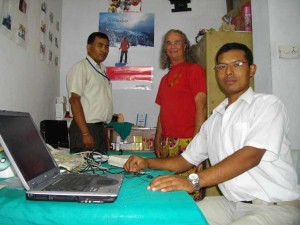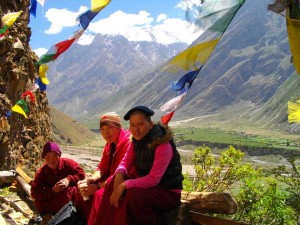History
This report follows four successful NAFA/FPMT/SULU/NAHOH trips to Nepal, conducting programs, establishing a fully equipped, reliably powered, hearing diagnostic and rehabilitation mobile clinic. We have been able to train local health workers in the use of the equipment, and have learned so much from them about the care and repair of primary ear infection and causes.
So, we have 76 new hearing aids fitted, 20 listening devices fitted, primary ear care programs spreading through schools, monasteries and remote communities. Can you imagine the experience of witnessing so much new found joy by our recipients!
Provision of reliable power sources and hearing test and rehabilitation equipment is essentially completed, with the equipment (including battery chargers, inverters, and power storage units) supplied by SULU and NAFA.

The Abbot of Kopan Monastery Kenrinpoche Lama Lhundrup discusses our program with Sue and mascots Black Bear and Rachel. The seed to visit Tsum Valley is sown!
Initially, screening and diagnostic equipment was set up at FPMT – KOPAN Monastery, Kathmandu, Nepal- resulting in a local training program of screening, primary ear care and maintenance of hearing aids fitted by us and also others purchased else where.
Beneficiaries of this free service were monks and nuns, and locals from surrounding areas.
With encouragement from NAFA, hearing screening, primary ear care and hearing aids were provided at Thimi VSN School (on the outskirts of Kathmandu, Nepal) and a village in the Hilly Region, Tawal.

Beg, NAFA sponsored Health worker – at remote Tawal clinic) being trained by Sue and Lew to use equipment sponsored by NAFA.
All equipment, Audiologist Sue and Engineer Audiometrist Lew (SULU) were supplied through Sue’s company, Whitsunday Hearing and Lew’s “Tuki Marine Surveys P/L” supplied the power sources.
Generous equipment supplier support in Australia – Bernafon, GN Otometrics, Word of Mouth, Docs Proplugs has made it possible.
It was paramount that a sustainable program (local need and desire for hearing assistance, practically applied and affordable) could be established before external funding was sought.
Sustainability of the program, with impermanence of SULU the prime impediment, was given credibility when we were joined by NAHOH, a local group of volunteers, well established, but hindered by lack of equipment. Initially set up to assist hearing impaired persons, they have become very proactive in primary ear care in local schools and adult groups. They have developed great expertise in these areas and have screened thousands of locals, treating problems and educating the masses. They have conducted ear camps involving surgical teams and provision of hearing aids, supported by local Rotary and Lions clubs, and IMPACT, an International foundation established to prevent and treat needless disability.

Keshab, volunteer “Ear Assistant” from NAHOH proudly uses hearing aid programming equipment supplied under the program.
A reliable quality power now supplied via charger, battery and full sine wave inverter. Clients can now be guaranteed testing and treatment, whenever they come to the Kirtipur clinic. This was previously interrupted by frequent “load shedding” power restrictions. President of NAHOH Macha Bhai and Lew look on.
It is imperative that all groups work together, which not only fosters community spirit in Nepal, but effectively uses expensive resources. The team at NAHOH have been able to specialist train Kopan Health Clinic monks in primary ear care, and will be available to assist with the screening of all student monks at the Kopan Monastery School. They will also screen all students associated with NAFA projects, Thimi VSN Schools, remote Hilly region Tawal schools and in time orphanages in the Kathmandu region. They are also available to program hearing aids fitted by Sulu or NAHOH.
David Hine, from Townsville, who has established his own program in Pokhara, is also teaching NAHOH members how to make ear moulds for hearing aids, and they in turn are sharing locally derived expertise in primary health care.
Screening of children is most important, as for very nominal sums of money, ear infections can be treated before they lead to hearing loss. Locally created education programs for children and adults are conducted in conjunction with school screenings. Adults are also treated and (if available) are also fitted with hearing aids. NAHOH monitors the use of all aids fitted outside of Kopan Monastery, ensuring correct maintenance and return for re-allocation if they are not being utilised sufficiently. Batteries are issued/ sold under this scheme.
Most recent program…..
TSUM VALLEY – June 2010
 Tsum is situated on the Tibet – Nepal border at an altitude of above 4000 metres (14,000 ft).
Tsum is situated on the Tibet – Nepal border at an altitude of above 4000 metres (14,000 ft).
90% of the population are of Tibetan origin.
The valley is reached after trekking for five long days after the road ends, in the northern Gorkha region of Nepal.
This is a sacred Buddhist valley and its people have been bypassed by mainstream development for centuries.

Local nuns gather outside Milarepa’s cave, at Phuktong Phuk. Milarep, a living Buddha, meditated here for a long time.
The kind hearted honest and peace loving people, can grow one crop a year, ( if the season is favourable ), of wheat, barley or vegetables , like potatoes and radishes. Killing is forbidden in the valley, so livestock, yak, zo, sheep and cows provide butter, cheese and wool.

Little boy with perforated ear drums has to wait 3 months to be taken to Kathmandu valley. NAHOH will care for him there
Monasteries are the hub of the villages, and in this region, Rachen Nunnery and Mou Monastery cared for by the FPMT organisation administered from Kopan Monastery in Kathmandu provide a base for our hearing program, available to all residents of the valley.
We were the first to provide such a service, and are actively raising funds to follow up next year with an enhanced program of primary ear care and rehabilitation. Please see report below.
An extract from the clinical report reads…..
FACT SHEET
Location: Rachen Nunnery medical clinic, Tsum Valley, NEPAL
Team members:
- Sangye Tenzin, In-charge Kopan Monastery medical clinic
- Tashi, Health worker, Kopan Monastery medical clinic
- Lew, Audiometrist, Queensland, Australia
And assisting
- Tenzin Lhamo, English teacher, Rachen Nunnery
- Paksho, Interpreter, from near by Chokhang village
With thanks to
- Kenrinpoche Lama Lhundrup, Abbot of Kopan, for requesting the program
- Tenzin Lundrup, Manager, Rachen Nunnery
- All the staff and nuns at the Nunnery, so much caring and kindness
AIM:
To assess and provide immediate benefit in the region’s ear health and hearing ability.
TARGET SUBJECTS:
Any person of any age living or working in the Tsum valley with an ear health or communication issue.
ACTION:
Screen all persons who present with a hearing problem
- Using Video otoscope, inspect ears and note whether clear or % wax, condition of ear drum, any fungus or discharge
- Refer to Lew for full test if hearing loss in better ear greater than 50 dB, or ear discharge, or ear drum perforation
- Refer to Tashi for wax / obstruction removal, prior to going home or seeing Lew
- Refer to Tashi for ear drops or medication for infection
Lew would conduct full hearing test, including confirmation of otoscopy, Air conduction and bone conduction tests, and tympanometry.
Fitting of hearing devices if better ear had 3FA > 50 dB, or special cases as assessed.
RESULTS:
Number persons screened:
102 persons, Youngest child – 2yrs, Oldest adult – 85 yrs
Referred for wax removal: 23 ears
Referred for medical advice, but unable to go to Kathmandu
- Ear drum perforations 25 ears
- Large difference in right / left hearing ability, sudden onset of hearing loss with tinnitus 15 persons
Referred to NAHOH, Nepal Association of the Hard of Hearing, Kirtipur. 3 persons
This is a volunteer organization which is supported by Lew and his Audiologist wife, Sue. They provide a clear medical assessment and appropriate treatment pathway. This way persons from remote areas have a contact in Kathmandu, and can assess better the value of setting out for the city, 5 days walking away
Referred to Audiologist Sue (in Australia) as a matter of urgent case study – 6 persons
Referred to Audiologist Sue as a matter of assessment review, 45 persons
Medium power behind the ear hearing aid fitting, (Bernafon Neo 112, temporary Doc’s Promould, Dry aid kit with regenerating silica gel drying agent- for hearing aid storage, and an ear impression taken for a custom mould – provided by Bernafon Australia, to be fitted, no later than one year hence). 28 persons
High power behind the ear hearing aid fitting, (Bernafon Extreme 121, temporary Doc’s Promould, Dry aid kit with regenerating silica gel drying agent- for hearing aid storage, and an ear impression taken for a custom mould – provided by Bernafon Australia, to be fitted, no later than one year hence). 4 persons
“Maxi” alternate listening device for those elderly persons not wishing to cope with the management of a behind the ear hearing aid 4 persons, with one awaiting a sponsor
CONCLUSION:
- Camp was highly successful in achieving the AIM
- Professional ear care was provided within the competency of the team members
- Tsum valley residents were extremely grateful for the visit, and in general, very happy with relief from their problems, within team and material limits.
- Hearing aids were fitted outside best ideal practice of seeking medical advice prior to fitment, where medical referral was necessary.
- Local support for the project was overwhelming
RECOMMENDATIONS:
- Revisit next year. Some team members WILL NEED TO FLY IN AND OUT.
- Add to team: Sue, Audiologist, and ear technician from NAHOH. This will greatly raise the level of immediate service / advice, and provide valuable training for other team members.

